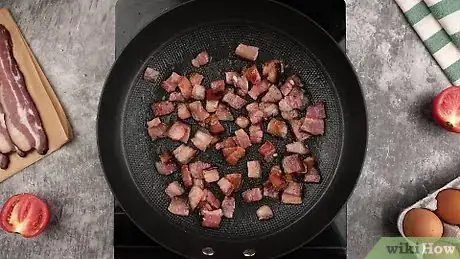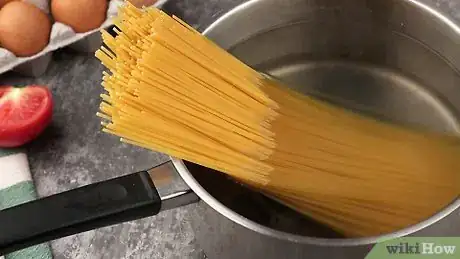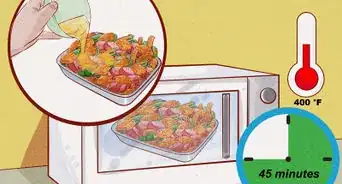This article was co-authored by wikiHow staff writer, Christopher M. Osborne, PhD. Christopher Osborne has been a wikiHow Content Creator since 2015. He is also a historian who holds a PhD from The University of Notre Dame and has taught at universities in and around Pittsburgh, PA. His scholarly publications and presentations focus on his research interests in early American history, but Chris also enjoys the challenges and rewards of writing wikiHow articles on a wide range of subjects.
There are 7 references cited in this article, which can be found at the bottom of the page.
The wikiHow Video Team also followed the article's instructions and verified that they work.
This article has been viewed 85,794 times.
Learn more...
Pancetta is sometimes called “Italian bacon,” but that hardly does it justice! Pancetta is cured (but unsmoked) pork belly that is seasoned with salt, pepper, and assorted spices, and rolled into a thick sausage shape. It should be cooked over medium-low to medium heat to render out some of the fat and make it crispy. You can use it interchangeably with bacon if you want to dial back the smoky flavor in a recipe, or try some great recipes that feature pancetta!
Ingredients
- 4 egg yolks and 2 whole eggs
- 1 pound (450 g) spaghetti or other dried pasta
- 4 oz (110 g) pancetta, diced into 0.25 in (0.64 cm) cubes
- 2 US tbsp (30 mL) olive oil
- 2 oz (57 g) shredded parmesan cheese
- salt and pepper to taste
Steps
Crisping Pancetta in a Frying Pan
-
1Slice or cube your uncooked pancetta as needed. Generally speaking, you can buy pancetta in a sausage-shaped roll, thinly sliced, or pre-diced. If you’re using thin slices or diced pancetta, you can cook them as is. To cook rolled pancetta, you’ll have to do a bit of slicing and possibly dicing.[1]
- You can cut thick, 0.25 in (0.64 cm) slices from the roll to cook.
- Or, cut thick slices and then dice them into 0.25 in (0.64 cm) cubes.
-
2Add your pancetta to a roomy frying pan. If you crowd your frying pan with pancetta, it will end up more soggy than crispy due to the excess of rendered fat and released moisture. Either choose a large frying pan that can easily accommodate all your pancetta, or cook it in batches.
- Whether sliced or diced, none of your pancetta pieces should be touching in the pan. If they are, it’s too crowded.
Advertisement -
3Place the pan and pancetta on medium-low to medium heat. By putting the pancetta in an unheated pan and then cooking it on a lower heat setting, you’ll render out more of the fat and crisp it without burning it. Stovetop settings vary widely, so aim for anywhere from medium-low to medium.
- If you’re cooking multiple batches, consider using two pans. Otherwise, you should remove most of the rendered fat and let the pan cool a bit between batches.
-
4Cook it until the fat renders and the pancetta is crispy. Even on a lower heat setting, pancetta doesn’t take long to go from perfectly crispy to unpleasantly burned. Use your eyes and your nose to know when it’s done just right for your liking.
-
5Place the cooked pancetta on a paper towel lined plate. The paper towels will soak up a bit of the surface fat on the pancetta, which will help it to remain crispy for a little longer after cooking. After cooling for a few seconds, it’s ready to add to salads, pastas, sandwiches, or any number of recipes, or just to munch on by itself![5]
- Before disposing of the pan drippings, see if they are used in any recipe you might be following.
Making Classic Pasta Carbonara with Pancetta
-
1Cube your pancetta, beat the eggs, and heat the cooking water. Dice 4 oz (110 g) of pancetta into 0.25 in (0.64 cm) cubes. Whisk 4 egg yolks and 2 whole eggs in a bowl with a bit of pepper and 1.5 oz (43 g) of shredded parmesan cheese. Heat 6 c (1.4 L) of water to a boil.[6]
- Add a couple of pinches of salt to the water, if desired.
-
2Crisp the pancetta in a Dutch oven or heavy-duty pot. Cook the pancetta until crispy in 2 US tbsp (30 mL) of olive oil over medium heat. Remove the pancetta and leave about 3 US tbsp (44 mL) of fat in the Dutch oven—drain and discard any excess fat.[7]
- It will take around 5 minutes for the pancetta cubes to turn crispy.
-
3Boil your pasta. While the pancetta is cooking, add 1 lb (450 g) of pasta (e.g., spaghetti) to the water and cook it until it’s just a bit firmer than you prefer. Save 28 fl oz (830 mL) of the cooking water and drain the pasta.[8]
- Aim for just short of al dente, the Italian term for perfectly cooked pasta.
- It will probably take about 7-9 minutes to reach the desired level of doneness.
-
4Finish cooking the pasta in the Dutch oven. Add 16 fl oz (470 mL) of the cooking water to the Dutch oven and place it over medium-high heat. Add the pasta and stir it regularly until it cooks to your prefered tenderness.[9]
- This will coat and infuse the pasta with the flavorful fat left in the Dutch oven.
-
5Create a sauce with the beaten eggs. While slowly whisking the beaten mixture of 2 whole eggs and 4 egg yolks, add 4 fl oz (120 mL) of the warm pasta water. Then slowly drizzle the egg mixture over the pasta while stirring it with tongs. Add a bit more of the remaining pasta water as needed to further thin the sauce, while continuing to toss and stir the pasta with the tongs.[10]
- Adding a small amount of warm liquid to eggs is called tempering them. It increases the eggs’ temperature slowly so that they don’t curdle or scramble.
-
6Add the pancetta and serve your carbonara. Toss in your cooked pancetta cubes and add shredded parmesan cheese and pepper to your liking. Divide the pasta into 4 generous servings.[11]
- This makes a hearty meal on its own, served with some crusty bread and a garden salad. Or, try pairing it with a grilled chicken breast and some steamed broccoli.
- Carbonara is best eaten right away, or the eggs will begin to congeal and get tougher. Leftovers can be refrigerated to eat within the next 1-2 days, but the quality won’t be the same.
Ensuring Your Pancetta’s Quality
-
1Buy it in rolls, slices, or cubes. If you want the best value and most flexibility in how you cut and serve your pancetta, buy it in its original rolled form. For slices that are thinner than those you’ll be able to cut yourself at home, buy a package of pre-sliced pancetta. If you’ll be using the pancetta as a topping or add-in for a salad, sauce, etc., consider buying it pre-cubed.[12]
- You can buy pancetta at Italian markets and specialty stores, as well as many delis and supermarkets.
- Authentic Italian-made pancetta will probably be more pricey than versions made in the U.S., Canada, or elsewhere. Let you taste buds decide if it’s worth the extra expense.
-
2Choose pancetta that’s pink, damp, and marbled with fat. Pancetta is cured but uncooked, so it should retain a color and texture akin to quality raw bacon. The fat should be white (not yellow or gray) and marbled throughout the meat. If the pancetta looks watery, greasy, or dried out, don’t buy it.[13]
- If you’re able to smell the pancetta, check for any rancid or other off odors. Don’t buy it if it stinks.
-
3Keep it sealed in the fridge until you’re ready to use it. Keep packaged pancetta sealed in its original container, or wrap a slab of pancetta in wax paper and put it in a zip-close bag. Most pancetta will last for 1-3 weeks in the fridge—if it starts to look yellow or gray, smells rancid, or is past its marked expiration date, don’t use it.[14]
- You can also freeze pancetta and keep it for up to 6 months.
Things You’ll Need
Crisping Pancetta
- Large frying pan
- Wooden spoon or rubber spatula
- Plate lined with paper towels
Pasta Carbonara with Pancetta
- Large pot for boiling pasta
- Colander
- Measuring cups and spoons
- Large mixing bowl
- Whisk
- Dutch oven or heavy-duty pot
- Wooden spoon or rubber spatula
- Tongs
References
- ↑ https://www.craftsy.com/cooking/article/how-to-use-pancetta/
- ↑ https://www.chowhound.com/recipes/pan-crisped-pancetta-18993
- ↑ https://www.bbcgoodfood.com/glossary/pancetta
- ↑ https://saramoulton.com/2015/02/pancetta-what-is-pancetta-and-how-do-you-cook-it/
- ↑ https://www.chowhound.com/recipes/pan-crisped-pancetta-18993
- ↑ https://www.bonappetit.com/recipe/simple-carbonara
- ↑ https://www.bonappetit.com/recipe/simple-carbonara
- ↑ https://www.bonappetit.com/recipe/simple-carbonara
- ↑ https://www.bonappetit.com/recipe/simple-carbonara
- ↑ https://www.bonappetit.com/recipe/simple-carbonara
- ↑ https://www.bonappetit.com/recipe/simple-carbonara
- ↑ https://www.thekitchn.com/whats-the-difference-between-bacon-pancetta-prosciutto-ingredient-intelligence-79111
- ↑ https://www.bbcgoodfood.com/glossary/pancetta
- ↑ https://saramoulton.com/2015/02/pancetta-what-is-pancetta-and-how-do-you-cook-it/
- ↑ https://www.bonappetit.com/ingredient/pancetta





























































